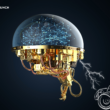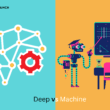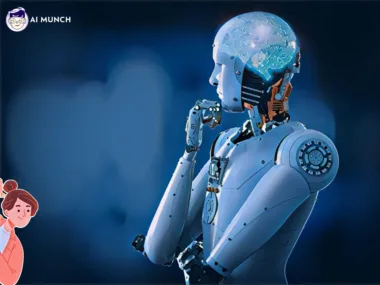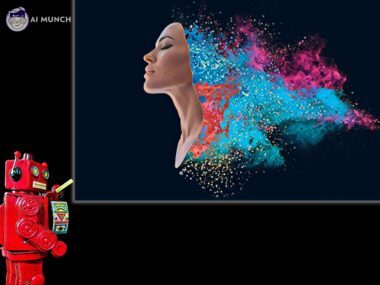I. Introduction
There is nothing hidden in the combination of AI and green power. There is a huge debate going on about artificial intelligence in energy and utilities. Artificial intelligence is being used in many fields. Artificial intelligence (AI) is being used more and more in the energy sector to simplify and automate a number of tasks. Artificial intelligence (AI) can forecast and enhance the performance of renewable energy facilities like solar and wind power plants and enhance the effectiveness of energy storage infrastructure. Artificial intelligence can also evaluate smart meter data to manage energy better and anticipate consumer needs. New energy technologies, such as better batteries and electric vehicles, are also being developed with the help of AI. When used everywhere, AI has the potential to improve the power sector’s efficiency and durability in a big way.
A. Explanation of AI and its potential in various industries:
Many financial companies are already using AI. The majority of these companies are directly or indirectly connected to the energy sector as well. In computing, “AI” stands for “artificial intelligence,” which describes the simulation of human intelligence processes by machines. Learning, reasoning, and self-correction are all examples of such operations. Several sectors, such as healthcare, banking, transportation, and more, stand to benefit significantly from the advent of AI. AI can also automate prediction, process optimization, and other daily duties.
B. Brief overview of the energy industry and its current challenges:
Applications of AI to the energy and utilities sectors are increasing day by day. The generation, transmission, and utilization of energy are all within the purview of the energy sector. It consists of conventional fossil fuels like coal, oil, and natural gas and alternative energies like solar, wind, and hydro. Increasing demand for energy, cutting greenhouse gas emissions, and enhancing energy efficiency are just a few of the difficulties facing the energy business today.
II. Improving Efficiency
A. Explanation of how AI is used to optimize energy consumption and reduce waste:
Artificial intelligence can be used to examine energy usage data for trends and inefficiencies. Energy providers can use this information to pinpoint problem areas and devise solutions to boost efficiency and reduce waste. Artificial intelligence can be used to keep tabs on and regulate the HVAC, lighting, and manufacturing equipment of a building or factory to ensure optimal efficiency. Artificial intelligence has the ability to cut down energy use and associated expenses by optimizing procedures.
B. Real-world examples of AI-assisted energy efficiency in buildings and industrial processes:
Energy efficiency in buildings and manufacturing processes are just two areas where artificial intelligence is being put to use. To cut costs, HVAC, lighting, and other building systems may all benefit from AI-enhanced building management. Artificial intelligence may help manufacturers streamline their operations and spot areas for improvement. Industrial machinery and home appliances may be made more energy efficient with the help of AI.
C. Discussion of potential future developments in this area, such as using AI to predict and prevent equipment failures:
Energy and AI are both part of the world’s sustainability goals. The application of artificial intelligence to identify and prevent equipment failures holds great promise for significantly enhancing energy efficiency in the not-too-distant future. For instance, AI systems could use machine learning algorithms to foresee when machinery will go down and plan preventative maintenance accordingly.
As a consequence, there would be less loss of energy, as well as fewer malfunctions that were not predicted. The term “smart grid” refers to a type of energy distribution system that uses artificial intelligence (AI) to improve energy distribution while dramatically cutting transmission losses.
Yield mapping meets #AI!
— Office of Energy Efficiency and Renewable Energy (@eeregov) January 28, 2023
Learn about @INL’s new tool, developed with our Bioenergy Office, that can save growers time and money on their crop treatments, while benefiting the environment: https://t.co/w5Kb0FAXwO #bioenergy pic.twitter.com/RG6MfUmpjt
III. Reducing Costs
A. Explanation of how AI is used to optimize energy production and distribution:
AI has the potential to boost the efficiency of the energy industry overall. This information can be utilized to foresee future energy demands and modify production accordingly. Companies that deal with energy could benefit financially from this. AI is used in smart grids to make sure that less power is lost during transmission. This is just one way that AI can be used in the energy sector to make sure that power is distributed well. Energy suppliers and consumers alike may benefit from these cost-cutting measures.
B. Real-world examples of AI-assisted cost reduction in the energy industry:
When it comes to cutting expenses, the energy sector is rich with real-world examples of AI’s benefits. Some utilities are already making use of AI to foresee future energy needs and alter production accordingly. That way, they may cut expenses by avoiding overproduction. Further, smart grid technologies driven by AI are being used to distribute energy better and lessen losses in transmission. Costs associated with energy distribution can be reduced as a result.
C. Discussion of potential future developments in this area, such as using AI to create more efficient and cost-effective renewable energy systems:
One potential use of artificial intelligence (AI) in the future energy sector is the improvement and cutback of the cost of renewable power sources. Artificial intelligence (AI) may improve the efficiency of renewable energy sources like solar and wind by, for instance, predicting the weather. It will be simpler for individuals and businesses to adopt renewable power and cut costs with AI because of its ability to improve energy storage and management.
IV. Promoting Renewable Energy Sources
A. Explanation of how AI is used to improve the performance and reliability of renewable energy systems:
The use of AI in energy is inevitable. Artificial intelligence can boost the efficiency and dependability of solar and wind power systems, among others. Artificial intelligence (AI) can help maximize solar and wind power generation by forecasting weather patterns and regulating output accordingly. Monitoring and maintaining renewable power systems can also benefit from AI, which can help increase reliability while decreasing unplanned downtime. Likewise, artificial intelligence can improve the efficiency and affordability of renewable energy sources, contributing to their viability.
B. Real-world examples of AI-assisted renewable energy projects:
There are many real-world AI uses in the favor of renewable power sources exist. Some utilities use AI to foresee weather patterns and maximize solar and wind power output, for instance. In addition, renewable power systems are being monitored and maintained with the help of AI-powered technologies, which can increase their dependability and decrease downtime. Energy management systems powered by artificial intelligence are also being used to maximize efficiency and reduce waste.
C. Discussion of potential future developments in this area, such as using AI to predict weather patterns and optimize energy production from solar and wind power:
Artificial intelligence (AI) can improve weather forecasting and the future efficiency of renewable power sources like solar and wind. For example, better energy storage and management systems might be developed using AI to make renewable power systems more efficient and less expensive. To further strengthen the grid’s dependability and stability, AI can be employed to maximize the incorporation of renewable energy sources.
V. Conclusion
A. An Overview of Artificial Intelligence’s Role in the Energy Sector:
In this article, we looked at how artificial intelligence (AI) — makes things more efficient, cuts costs, and raises awareness about the need for renewable energy. We have examined how AI may be used to enhance the efficiency and dependability of renewable energy systems and how it can be used to optimize energy use and production.
B. A looks at the probable future effects of AI in the energy sector:
Artificial intelligence has the potential to alter the energy sector in the long run significantly. The generation, transmission, and use of power might all be dramatically changed by AI. It could make the energy sector more efficient, affordable, and long-term. It is essential to reduce greenhouse gas emissions and prevent climate change, and AI can assist in encouraging the use of renewable energy sources.
FAQs
The application of artificial intelligence is helping forecast weather patterns and improve the efficiency of energy generation from renewable sources such as solar and wind power. This helps to boost the efficiency as well as the cost-effectiveness of systems that utilize renewable energy.
Thanks to AI research and development, storage solutions for renewable energy are becoming cheaper and more efficient. The ability to store excess energy for later use is a significant step toward making renewable energy widely applicable.
With the help of AI, energy management systems are becoming more effective and affordable. By gaining a deeper insight into and control over their energy use patterns, both energy providers and end users may save money.
AI can improve grid management and control by forecasting and eliminating power outages, improving energy distribution, and ensuring the integration of renewable energy sources.
Renewable energy sources are becoming more AI-efficient, reducing energy use and waste. There will be less pollution from the energy sector because of this. Energy companies are using AI to optimize the use of carbon capture and storage technology, this process is reducing pollution as well.
Do you want to read more? Check out these articles.











3 comments